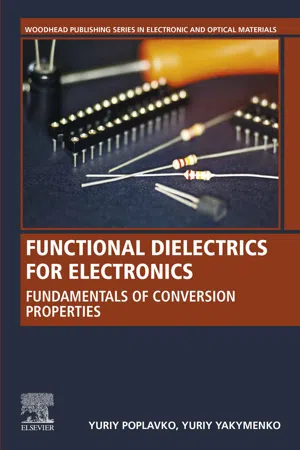
Functional Dielectrics for Electronics
Fundamentals of Conversion Properties
- 312 pages
- English
- ePUB (mobile friendly)
- Available on iOS & Android
Functional Dielectrics for Electronics
Fundamentals of Conversion Properties
About This Book
Functional Dielectrics for Electronics: Fundamentals of Conversion Properties presents an overview of the nature of electrical polarization, dielectric nonlinearity, electrical charge transfer mechanisms, thermal properties, the nature of high permittivity, low-loss thermostability and other functional dielectrics. The book describes the intrinsic mechanisms of electrical polarization and the energy transformations in non-centrosymmetric crystals that are responsible for converting thermal, mechanical, optical and other impacts into electrical signals. In addition, the book reviews the main physical processes that provide electrical, mechanoelectrical, thermoelectrical and other conversion phenomena in polar crystals.
Detailed descriptions are given to electrical manifestations of polar-sensitivity in the crystals, the interaction of polarization with conductivity, the anomalies in thermal expansion coefficient and main peculiarities of heat transfer in polar-sensitive crystals.
- Provides readers with a fundamental understanding of polar dielectric materials and their physical processes
- Includes different models of polar sensitivity and experimental confirmation of these models
- Discusses thermal expansion, heat transfer, dielectric nonlinearity and other important aspects for electronics applications
Frequently asked questions
Information
Physical nature of crystal internal polarity
Abstract
Keywords
1.1 Basic elementary mechanisms of polarization

Table of contents
- Cover image
- Title page
- Table of Contents
- Copyright
- Preface
- Introduction
- 1: Physical nature of crystal internal polarity
- 2: Manifestations of polar sensitivity in crystals
- 3: Thermal physics of polar crystals
- 4: Pyroelectricity
- 5: Piezoelectricity
- 6: High permittivity microwave dielectrics
- Index